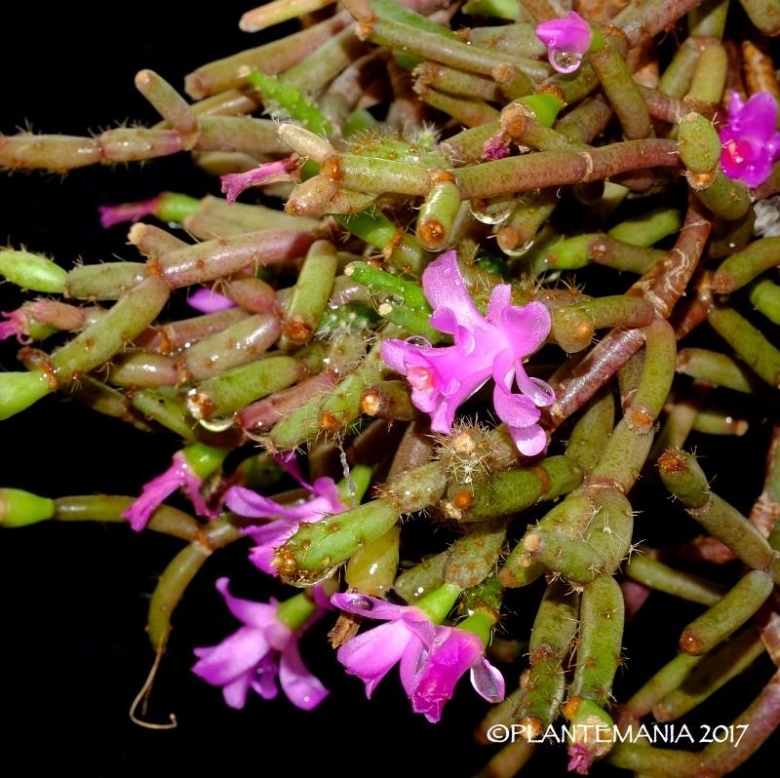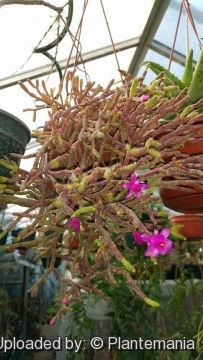
Hatiora herminiae Photo by: © Plantemania
Origin and Habitat: Hatiora herminiaeSN|33515]]SN|33515]] is endemic to Brazil occurring in Rio de Janeiro, Minas Gerais and Sao Paulo. This species has an extent of occurrence of approximately 500 km2, it is known from two locations.
Altitude range: 1,500 to 2,000 metres above sea level.
Habitat and Ecology: It grows as an epiphyte on Araucaria in cloud forests. The population is small and probably declining due to collection by people - it has beautiful flowers so people are attracted to it.
Synonyms:
Description: Hariota herminiaeSN|33516]]SN|33516]] is an epiphytic, erect or sometimes arching over succulent shrubs, to 30 cm high, branching dichotomously or in whorls. The flowers are dark pink to blue-violet, 2 cm long. The fruit are olive green. It looks a lot like Hatiora salicornioidesSN|22941]]SN|22941]] and also grows upright but doesn’t quite have the same little stems segments.
Derivation of specific name: For Prof. Herminia Castellanos, wife of the Argentinian botanist Alberto Castellanos.
Stem segments: Older basal stems brown, upper ones grey, matte dark green or olive green, purplish in full sun, dichotomous or whorled, cylindrical, only slightly thickened higher up (clavate), not ribbed or slightly 3-5-furrowed, 2-5 cm long, to 0.5 cm in diameter, with felt on tips.
Areoles: Few, small, lateral, bearing small scales and one or two small bristles. Terminal areola c 5 cm in diameter with abundant greyish hairs.
Flowers: Usually solitary, rarely paired, from terminal areoles, rose pink, pinkish magenta or blue-violet, to 1-2(-2.5) cm long and 1-2.5 cm in diameter. Pericarpel 4-5 mm long, 2-4 mm in diameter, hemispherical, pale green or yellow-green near the base. Perianth segments magenta. Filaments, anthers, stigma-lobes and e nectary disc crème-coloured.
Fruits (berries): olive green, up to 8 mm long.
Seed: Chestnut-brown.
Bibliography: Major references and further lectures
1) Daniela Zappi, Lidyanne Yuriko Saleme Aona & Nigel Taylor “CACTACEAE” Parte integrante da "Flora Fanerogâmica do Estado de São Paulo", vol. 5. Zappi, D., Aona, L.Y.S. & Taylor, N. 2007
2) David Hunt, Nigel Taylor “The New Cactus Lexicon” DH Books, 2006
3) Edward F. Anderson “The Cactus Family” Timber Press, 2001
4) Taylor, N.P. & Zappi, D. 2013. Hatiora herminiae. The IUCN Red List of Threatened Species 2013: e.T152047A591015. http://dx.doi.org/10.2305/IUCN.UK.2013-1.RLTS.T152047A591015.en. Downloaded on 07 January 2017.
5) Willy Cullmann, Erich Götz (Dozent Dr.), Gerhard Gröner “The encyclopedia of cacti” Timber Press, 1987
6) Urs Eggli, Leonard E. Newton “Etymological Dictionary of Succulent Plant Names” Springer Science & Business Media, 29 June 2013
7) Hans Hecht “Cacti & succulents” Sterling Pub. Co., 1997
8) Clive Innes “Complete Handbook of Cacti and Succulents” Van Nostrand Reinhold Company, 01/Dec/1981
 Hatiora herminiae Photo by: © Plantemania
Hatiora herminiae Photo by: © PlantemaniaSend a photo of this plant.The gallery now contains thousands of pictures, however it is possible to do even more. We are, of course, seeking photos of species not yet shown in the gallery but not only that, we are also looking for better pictures than those already present.
Read More... Cultivation and Propagation: Hariota herminiaeSN|33516]]SN|33516]] is rarely grown as an ornamental as it is hard to keep and is prone to shedding it's stems if something is wrong (under/over watering being the most common. Likes humidity, and bright, but indirect light, loose soil, regular watering (Careful!), and the occasional fertilizer. These forest cacti are best grown as a graft.
Soil: This type of soil would normally be used for orchids, bromeliads or other epiphytic plants.
Exposure: The will grow much better outside in summer in the shade.
Waterings: They require ample summer water and partial shade, but allow soil to dry slightly between waterings. During the flowering cycle keep them moist (but not soggy). After the blossoms have fallen off you should back off on the water for a couple of months. If they need repotting, this is the time to do it.
Remarks:* They drop their buds easily if they are moved. Once flower buds have formed, DO NOT MOVE the plant, as slight changes in environment may cause the buds to drop.
Propagation: Stem cuttings, seeds or grafting. Cuttings will root slowly. Put them on the ground, not in the ground. Use very coarse soil, whether organic of mineral. Do not soak. (For grafting this plant Acanthocereus pentagonusSN|4326]]SN|4326]] and Selenicereus are good stocks) If you are not very experienced with these type of plants, a rooted or grafted cutting can be a better approach. Plants are self-fertile, so only one plant is needed to get seeds. To get from flower to seed will take about one year. From seed to a flowering plant will take some more years.












